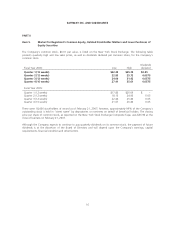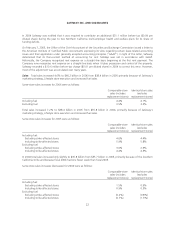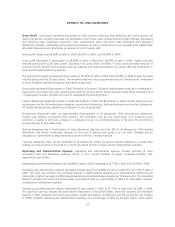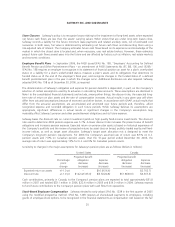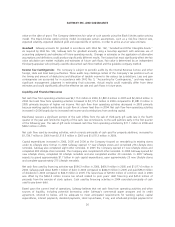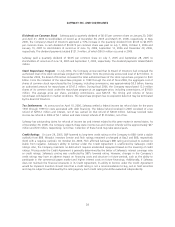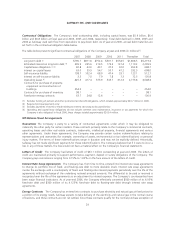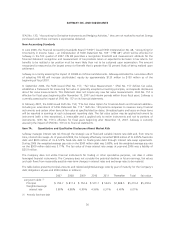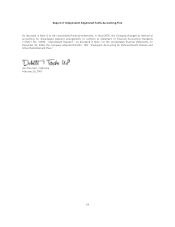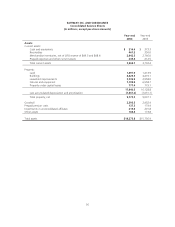Safeway 2006 Annual Report Download - page 44
Download and view the complete annual report
Please find page 44 of the 2006 Safeway annual report below. You can navigate through the pages in the report by either clicking on the pages listed below, or by using the keyword search tool below to find specific information within the annual report.SAFEWAY INC. AND SUBSIDIARIES
value on the date of grant. The Company determines fair value of such awards using the Black-Scholes option pricing
model. The Black-Scholes option pricing model incorporates certain assumptions, such as a risk-free interest rate,
expected volatility, expected dividend yield and expected life of options, in order to arrive at a fair value estimate.
Goodwill Safeway accounts for goodwill in accordance with SFAS No. 142, “Goodwill and Other Intangible Assets.”
As required by SFAS No. 142, Safeway tests for goodwill annually using a two-step approach with extensive use of
accounting judgments and estimates of future operating results. Changes in estimates or the application of alternative
assumptions and definitions could produce significantly different results. The factors that most significantly affect the fair
value calculation are market multiples and estimates of future cash flows. Fair value is determined by an independent
third-party appraiser who primarily used the discounted cash flow method and the guideline company method.
Income Tax Contingencies The Company is subject to periodic audits by the Internal Revenue Service and other
foreign, state and local taxing authorities. These audits may challenge certain of the Company’s tax positions such as
the timing and amount of deductions and allocation of taxable income to the various tax jurisdictions. Loss and gain
contingencies are accounted for in accordance with SFAS No. 5, “Accounting for Contingencies,” and may require
significant management judgment in estimating final outcomes. Actual results could materially differ from these
estimates and could significantly affect the effective tax rate and cash flows in future years.
Liquidity and Financial Resources
Net cash flow from operating activities was $2,175.0 million in 2006, $1,881.0 million in 2005 and $2,226.4 million in
2004. Net cash flow from operating activities increased to $2,175.0 million in 2006 compared to $1,881.0 million in
2005 primarily because of higher net income. Net cash flow from operating activities decreased in 2005 primarily
because working capital contributed to cash flow at a lower level than in 2004. Net cash flow from operating activities
increased in 2004 largely due to increased net income and contributions from working capital.
Blackhawk receives a significant portion of the cash inflow from the sale of third-party gift cards late in the fourth
quarter of the year and remits the majority of the cash, less commissions, to the card partners early in the first quarter
of the following year. The sale of gift cards increased cash flow from operating activities by $71.1 million in 2006 and
$48.2 million in 2005.
Net cash flow used by investing activities, which consists principally of cash paid for property additions, increased to
$1,734.7 million in 2006 from $1,313.5 million in 2005 and $1,070.3 million in 2004.
Capital expenditures increased in 2006, 2005 and 2004 as the Company focused on remodeling its existing stores
under its Lifestyle store format. In 2006 Safeway opened 17 new Lifestyle stores and completed 276 Lifestyle store
remodels. Safeway also completed eight other remodels. In 2005 the Company opened 21 new Lifestyle stores and
completed 293 Lifestyle store remodels. The Company also completed 22 other remodels. In 2004 Safeway opened 32
new Lifestyle stores, completed 92 Lifestyle remodels and also completed another 23 remodels. In 2007 Safeway
expects to spend approximately $1.7 billion in cash capital expenditures, open approximately 25 new Lifestyle stores
and complete approximately 275 Lifestyle remodels.
Net cash flow used by financing activities was $596.3 million in 2006, $466.9 million in 2005 and $1,077.6 million in
2004. Safeway paid down $493.1 million of debt in 2006 compared to $444.9 million in 2005 and paid $96.0 million
of dividends in 2006 compared to $44.9 million in 2005. The repurchase of $318.0 million of common stock in 2006
was offset by the $262.3 million income tax refund related to prior years’ debt financing and $45.4 million of
proceeds from the exercise of stock options. Cash used by financing activities in 2004 consisted principally of cash
used to pay down debt.
Based upon the current level of operations, Safeway believes that net cash flow from operating activities and other
sources of liquidity, including potential borrowing under Safeway’s commercial paper program and its credit
agreement, referred to below, will be adequate to meet anticipated requirements for working capital, capital
expenditures, interest payments, dividend payments, stock repurchases, if any, and scheduled principal payments for
26


